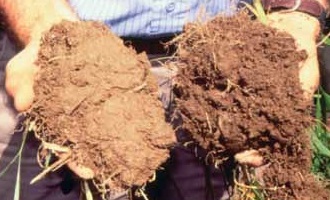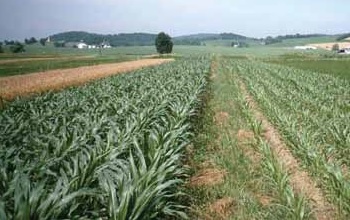On top of the issues of using genetically modified organisms (GMOs) and petrochemical fertilizers and pesticides, a key question is how many different crops go into fields. There are three criteria: how many together at once, how many across fields and how many across time. The use of non-crop plants involves in particular legumes (pulses), such as clover or alfalfa, to increase the nitrogen content of the soil; these are not harvested (hence "non-crop").
Rotations are possible with animals too: Polyface farm move their cattle from one meadow to another to avoid overgrazing and maximize grass growth, i.e. maximize photosynthesis. Then cattle is followed a few days later by chickens feeding on larvae in cowpats. The droppings from both feed the grass. (And pigs are used to aerate compost, but this is another story.)
Here is how the four types of agricultural practices look on these criteria ("conventional" is represented by the huge monocultures of corn or soybeans of the US Mid-west and South America or the large European wheat monocultures; some conventional cultures are less extreme, for instance rotating cultures).
| conventional | integrated | organic | permaculture | |
|---|---|---|---|---|
| crops in one field at a time | one | several | ||
| crops in all fields at a time | one | several | ||
| rotation over time | no | yes | no* | |
| fertilizers | chemical | organic | none provided | |
| pesticides | at will | limited | very limited | none |
| annuals or perennials | annuals | perennials* | ||
| use of non-crop plants | no | probably | yes | |
| mixed animal-crop farming | no | maybe | ||
| tillage | deep | shallow or none | none needed* | |
| GMO | varies by country | I am not sure | no | |
* Assuming perennials are used.

Annuals regrow from scratch (a seed) every year (e.g. wheat, tomato). Perennials (for instance trees) live for several years. Unlike annuals, perennials have roots year-long (as shown by the image on the right), which for instance helps to hold the soil and fight erosion. The use of perennials would imply that the same crops will be used in any plot of land over time (i.e. there is no rotation) and that no tillage is needed to plant new annuals every year.
Perennials are preferred by permaculture (see for instance landinstitute.org). Well, they are preferred in theory, but are they actually used in practice? not yet perhaps.
Nitrogen fertilization. Conventional agriculture uses chemical fertilizers made from methane (natural gas) using the Haber-Bosch method. Others shun chemicals and rely on organic fertilizers, such as compost and manure, which are added to the fields in a way similar to chemical fertilizers. Or they may instead fertilize without fertilizers, by growing legumes (either between crops or along with them); legumes can turn nitrogen from the air into nitrogen-containing molecules usable by plants.
Pest control. The conventional way is to use chemical pesticides. The first improvement is to use insecticide when relevant insects are spotted rather than prophylactically. Also different insecticides may be used that are less harmful (even though this is not an exact science: copper-based fungicides, e.g. "Bordeaux mixture", favored by organic growers can be toxic to humans). Instead of replacing pesticides with "natural" alternatives, integrated methods rely on predators to the bugs (e.g. ladybugs eat aphids, on top of being prettier than a tank of chemicals). Polyculture can also help since there may not be a critical mass of the right crop for pests to thrive on.
Weed control. The pattern is similar: chemicals, less chemicals, alternatives to chemicals. The last step again is relying on nature to prevent the problem instead of having to cure it; for instance, perennials are already there in the spring and have a head start on annual weeds.
Integrated and organic practices involve using different plants on the same plot over time (rotation). Also at any one time several plots will have different cultures (so, regardless of the weather that year, some will not give much but other will thrive). On the other hand, permaculture tries to look more like nature by having several types of plants together at the same time. All this can be labeled "polyculture", so this word is ambiguous. The opposite, monoculture, unambiguously fits the canonical practice of having only one culture (say corn or soy) on all land all the time; but permaculturists would say that crop rotation is in fact successive monocultures.
Organic agriculture relies on crop rotation, i.e. a succession of monocultures, a sort of poly-monoculture. The canonical midwestern cultures in the US are mono-monocultures of corn or soybeans. Permaculture is a mono-polyculture, since there are several crops (and non-crop plants) together at a time, but these do not change from year to year (which would be impossible in any case with perennials). The first three rows of the table can thus be summed up as:
| conventional | integrated | organic | permaculture |
|---|---|---|---|
| mono-monoculture | poly-monoculture | mono-polyculture | |
The table does not have any poly-polyculture for two reasons. As already pointed out, it would necessarily have to be annuals. Also it would gild the lilies: having several types of plants on a plot of land either at once or in succession avoids draining the soil of a specific nutrient, avoids catastrophic epidemics, provides fertilization (legumes), etc.; but doing both would not add anything.
Hydroponics is too idiosyncratic for a direct comparison: there is no question of tillage, erosion or preserving the soil fertility. Like conventional agriculture it feeds the plants, not the soil (what soil?), as the table below shows. There is a difference between hydroponic greenhouses, which use sunlight like the rest of agriculture, and hydroponics in windowless rooms (e.g. basements) where the light comes from lamps (e.g. LED). While conventional agriculture replaced natural nutrients with industrial ones, what I call hydroponic darkhouses also replaced natural light with industrial light — of course both are very resource-intensive.
| conventional agriculture | organic (and nature) | hydroponic greenhouse | hydroponic darkhouse | |
|---|---|---|---|---|
| soil | inert (in effect) | alive | none or inert (on purpose) | |
| light source | sunlight | electric | ||
Apart for the absence of a lively soil, hydroponics is different from conventional agriculture: it does not need as much pesticide because the absence of soil disturbs weeds, insects and parasites. Mixed farming is even possible: aquaponics uses both fish and plants, like a 21th century version of the old mixed farm with crops and animals, where chicken and pigs fed on dropped grain and on leftovers, and their wastes fed the crops.
A sustainable agricultural system must preserve topsoil quality (organic matter, biomass) and quantity (avoid erosion), avoid pollution (of the water by nitrate runoffs; of the air by the green-house gases CO2 and nitrous oxide, N2O). But meeting all these criteria is not enough: if this environmentally sustainable food production is prohibitively expensive, it will be a commercial failure (and bankruptcy is not sustainable). So yields are important too.

Soil from conventional (left) and organic (right) fields (source: Rodale Institute)
Chemical fertilization systems feed the crop, whereas organic systems feed the topsoil (or let nature do it), which in turn feeds the crop. The latter thus has a topsoil richer in organic matter (thereby darker), as shown in the image on the right. (This is why the table below claims that topsoil quality is somewhat irrelevant to conventional systems.)
Moreover, nutrients (nitrogen, phosphorus, potassium) in synthetic form are released faster than with compost, manure or legumes. There is thus a greater risk that these will end up in groundwater or rivers rather than in the plant: both a waste of money and a source of pollution. Fertilizers can also release nitrous oxide (N2O), a very potent green-house gas, and their production requires natural gas and energy — doing without them thus vastly reduces the climate impact of agriculture.

Corn in drought: with and without legumes
(source: Rodale Institute)
According to the Rodale Institute, organic systems are more resilient: "Organic corn yields were 31% higher than conventional in years of drought [better than] genetically engineered 'drought tolerant' varieties which saw increases of only 6.7% to 13.3%". The image on the left shows that conventional corn (right) is suffering from hydric stress during a drought, unlike corn grown with legumes (left).
Organic crops also "tolerated much higher levels of weed competition than their conventional counterparts, while producing equivalent yields". This is particularly interesting given that a key goal of GMO crops is herbicide resistance, which allows to use more and more herbicide, but also creates resistant weeds.
According to the Rodale Institute 30-year study of corn and soybean: "Organic yields match conventional yields" after a transition period. Moreover, "even without a price premium, the organic systems are competitive with the conventional systems." (But then why is organic food more expensive?) And if the food is grown locally, it is also cheaper to transport.
| conventional | integrated | organic | permaculture | |
|---|---|---|---|---|
| yield | very high | high | lower? | ?? |
| water pollution | common | no | ||
| topsoil erosion | high | low to negative | ||
| topsoil quality | low (and unnecessary) | higher | natural level | |
When he describes how he designed his house, Amory Lovins explains that adding some insulation reduces heating costs enough to be economical, then further insulation costs more than it saves on energy. But with a lot more insulation it becomes possible to "eliminate the building's heating system and thus avoid the entire capital cost of furnace, ducts, [etc.]" and thus save money.
With agriculture, reducing the consumption of chemical fertilizers and pesticides can be economical because it will reduce yields a little (if at all) but it will also reduce costs. However, a further reduction of chemicals, the savings may not be enough to compensate the yield loss. Yet, there is the possibility that a massive reduction would work — because even if pests are back their predators (e.g. ladybugs) would thrive too, or because the soil microfauna would be healthier. This complicates the situation because doing more of what does not seem to work may work.